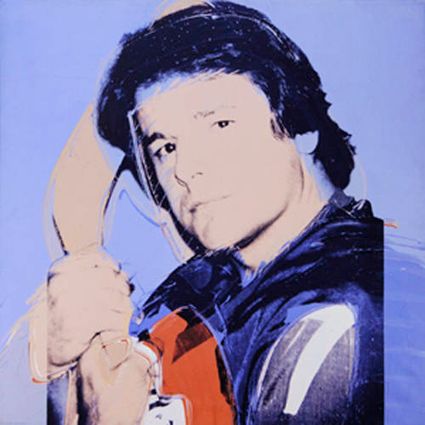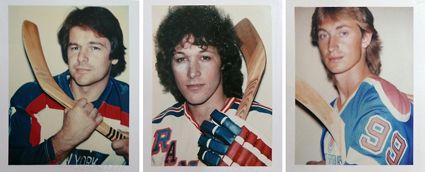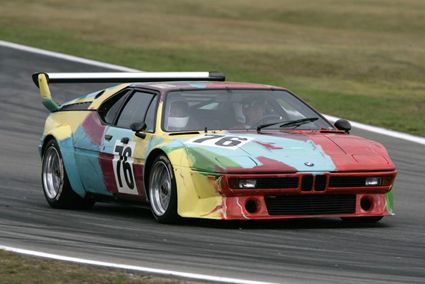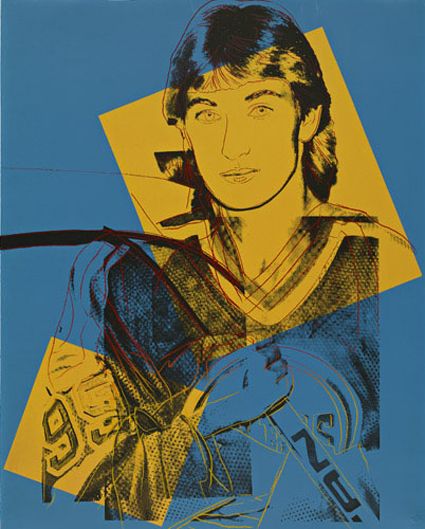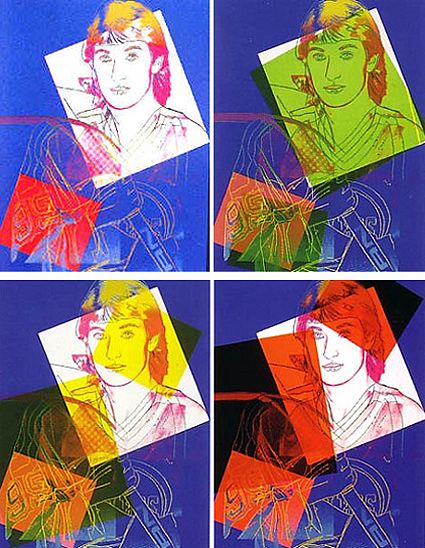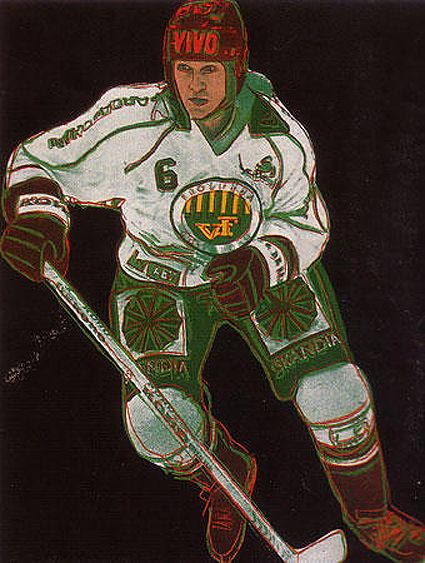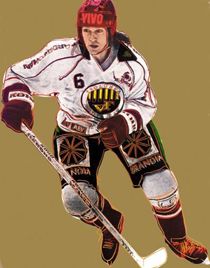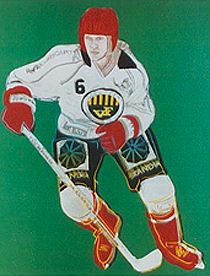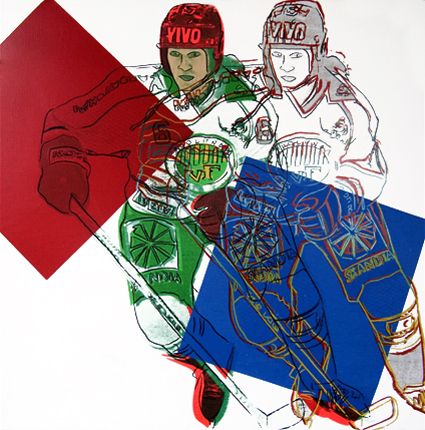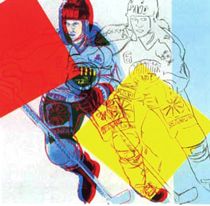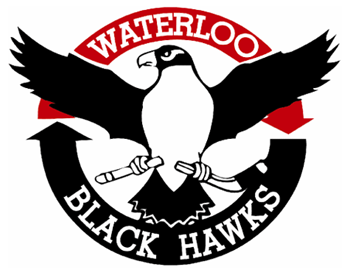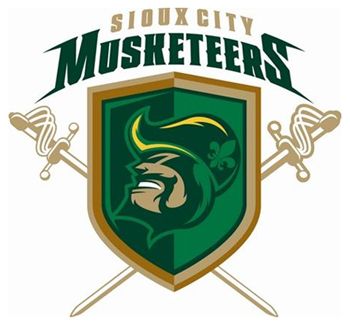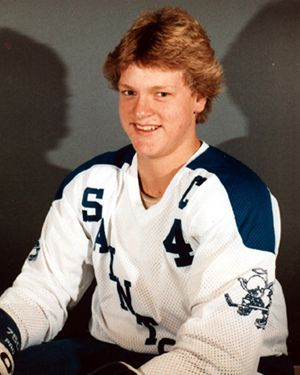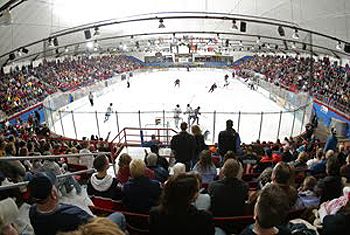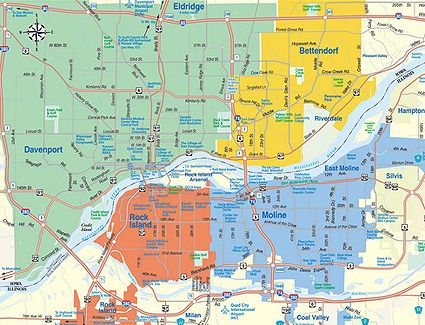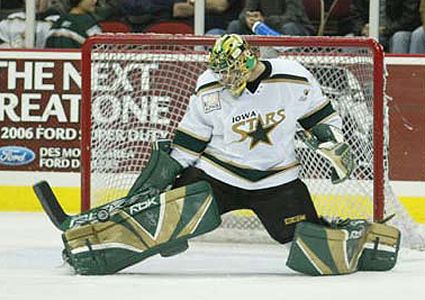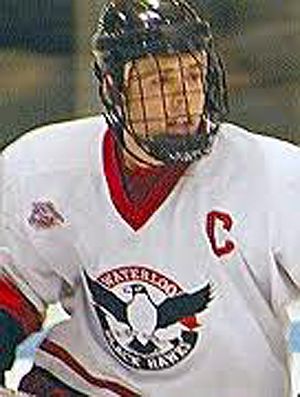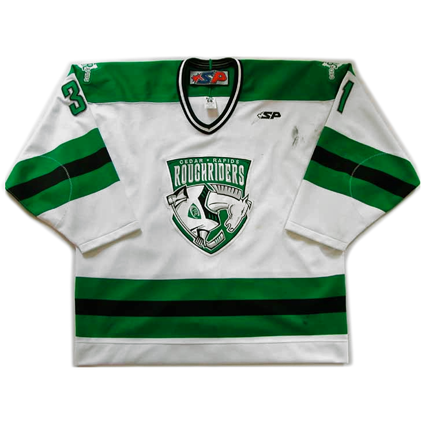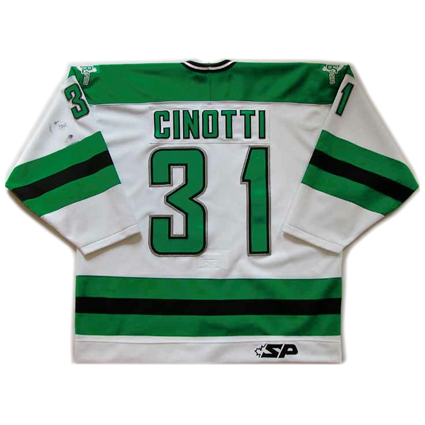Saturday, August 6, 2011
The Hockey Art of Andy Warhol
Born on this date in 1928, Andy Warhol is not the first name that comes to mind when thinking of sports related art, as he is best known for his portraits, such as those of celebrities like Marilyn Monroe, Jackie Kennedy and Liz Taylor, and political icons, such as Mao Tse-Tung, Vladimir Lenin and Che Guevara.
In addition to his paintings, Warhol was a filmmaker and also created works in many other media. He also introduced the phrase "15 minutes of fame" to the English lexicon.
From a monetary standpoint, Warhol ranks among a very elite group of artists, Jackson Pollock, Willem de Kooning, Gustav Klimt, Vincent van Gogh, Pierre-Auguste Renoir, Pablo Picasso and Warhol, who have had an individual piece sell for $100 million.
Warhol did create a number of sports related pieces throughout his career though, almost exclusivley on a commission basis. His first photo-silkscreened painting was a baseball scene, done in back in 1962. It was the first and last time he chose sports as a subject on his own.
Warhol's first real entry into the world of sports related art, and his first hockey piece, was when he was commissioned fifteen years later to create a series of works for businessman Richard Weisman in 1977, known as the "Athlete Series", which featured Jack Nicklaus, Kareem Abdul-Jabbar, Willie Shoemaker, Dorothy Hamill, Chris Evert, Pele, Tom Seaver, O. J. Simpson, Muhammad Ali and hockey player Rod Gilbert.
Rod Gilbert by Andy Warhol
On September 2, 2009 the ten 40" square canvases were stolen from the Los Angeles home of Weisman, along with a portrait of Weisman done by Warhol. Anyone with information about the theft can call the Los Angeles Police Department at 231-485-2524.
The polaroid photos Warhol took for the Athlete Series have been displayed on their own, and include additional portraits of hockey players Ron Dugay and Wayne Gretzky taken at a later time than those used to produce the Athlete Series.
Polaroid photos taken by Warhol as the basis for future paintings
In 1978, Warhol revisited one of the subjects of the Athlete Series, Muhammad Ali. Four separate pieces were created at that time.
One of Warhol's better known works related to the world of sports was the occasion when he was commissioned by BMW to paint one of their M1 race cars as the fourth in a series of BMW Art Cars, which would later compete at the famed 24 Hours of Le Mans.
"I tried to portray speed pictorially. If a car is moving really quickly, all the lines and colors are blurred.", Warhol explained. Of note, the car finished second in it's class and sixth overall out of 55 starters in 1979, the only time it ever raced.
His next sports themed work was that of a speedskater, which was his contribution to "The Official Art Portfolio of the XIV Olympic Winter Games" in Sarajevo, Yugoslavia in 1983. He was one of 17 artists to contribute to the project.
In 1984, Warhol produced two separate pieces commissioned by long-time Canadian art gallery owner Frans Wynans featuring Gretzky. One was entitled "Wayne Gretzky 99" and produced in a limited edition of 300.
As was often the case with Warhol's silkscreened prints, a variety of color versions can be found of this work. The silkscreen prints were originally sold for $1,500 and now require between $15,000-$20,000 to obtain.
The other piece was a series of six portraits of Gretzky holding a hockey stick. The portraits originally sold for $35,000 and now sell for more than ten times that much at $390,000.
Again, there were various versions of "Wayne Gretzky" produced despite the much more limited numbers produced.
As a fundraiser for the Cincinnati Art Museum, Warhol created a poster featuring Cincinnati baseball icon Pete Rose, done in the style of a baseball card in 1985. Also that same year, he created a polo player for the cover of the 10th anniversary of Polo magazine.
One final hockey themed work of Warhol's was "Frölunda Hockey Player" in which he depicts a skater from the Swedish club Frölunda HC, Christer Kellgren, which was created in 1986. The piece was a commissioned project by the Art Now Gallery in Göteborg, Sweden, which is home to the Frölunda Indians.
Typical of the works of Warhol, several distinct variations of this piece were made in widely differing colors.
There was also another group of the Frolunda Hockey Player made which featured two images of the player done in several variations.
Warhol died the following year at the age of 58 from a sudden cardiac arrhythmia following a routine surgery.
Today's video section will be unlike any other we've ever had, and it begins with Andy Warhol Eats a Hamburger.
Next, Andy appears in a commercial for Braniff Airlines with heavyweight boxing champion Sonny Liston. There's no way that's Andy's voice either.
Finally, "Andy Warhol" by David Bowie.
For more on Warhol, here is a link to the PBS American Masters series on Andy Warhol in 12 parts, which runs roughly two hours and contains absolutely no hockey whatsoever.
Labels:
Warhol Andy
Sunday, July 31, 2011
2007-08 Cedar Rapids RoughRiders Erick Cinotti Jersey
July by the Numbers makes our first ever visit to Iowa for jersey #31.
The oldest hockey team from the Hawkeye State we can find records for is the 1951-52 Sioux City Sunhawks, a senior amateur club in the American Amateur Hockey League. The Sunhawks lasted but one season but had a rather successful one, finishing second. This league was a precursor to what would eventually become the United States Hockey League.
The Sunhawks would be followed in the AAHL by the Des Moines Ice Hawks (1958-1960) and the Des Moines Oak Leafs in 1961. After two seasons in the USHL, the Oak Leafs would join the International Hockey League beginning in 1963. They would make the playoff finals twice in their nine seasons in the IHL prior to changing their name to the Des Moines Capitols in 1972. In 1973-74, they would finish with the best regular season record and go on to defeat the Saginaw Gears to win the Turner Cup as IHL champions, but after one additional season, the club would fold, ending their 14 year run.
The Waterloo Black Hawks joined the league, now renamed USHL, in 1962 and won championships in five consecutive seasons from 1964 to 1968 and then another trio of titles in 1975, 1978 and 1979, the final season the USHL operated as a semi-professional league.
The Sioux City Musketeers arrived in the USHL in 1972 and remained in the league when it changed it's focus to an all junior league for the 1979-80 season and have continued to play in the league to this day, making them the longest running franchise in the state of Iowa, now at 40 seasons of play. The Musketeers have won the Clark Cup as USHL champions in 1982, 1986 and 2002 and also went on to win the Gold Cup as national junior champions in 1986 as well.
The conversion of the USHL from a semi-pro to a junior league in 1979 opened up new opportunities which led to some changes and additions, as Waterloo relocated to Dubuque and were renamed the Dubuque Fighting Saints in 1980, where they remained for 21 seasons. The Fighting Saints won the Clark Cup in their very first season in Dubuque and added titles every other year for championships in 1981, 1983 and 1985.
Future NHL Rookie of the Year, Stanley Cup winner and US Olympian
Gary Suter captained the Fighting Saints to a Clark Cup title in 1983
Waterloo was not left without hockey though, as a Minnesota franchise immediately moved into the vacated Waterloo market and kept alive the traditional Black Hawks name. This new iteration of the Black Hawks has won the Clark Cup once, that coming in 2004.
After a five year absence, hockey returned to Des Moines when the Des Moines Buccaneers joined the USHL for the 1980-81 season and have proven to be a big success, having just completed their 31st season with USHL championships coming in 1992, 1995, 1999 and 2006 and national championships coming in 1992, 1995 and 2006.
The Des Moines Buccaneers playing in front of a packed house
Mason City became home to the North Iowa Huskies in 1983 and they would remain there through the 1998-99 season, 16 in all, before relocating and becoming the Cedar Rapids RoughRiders beginning with the 1999-00 season. The RoughRiders have now completed their 12th season with a Clark Cup championship in 2005.
While not technically based in Iowa, the history of hockey in the Quad Cities must be mentioned in any discussion of Iowa hockey, as the Quad Cities consist of Rock Island and Moline in Illinois and Bettendorf and Davenport on the Iowa side of the Mississippi River. The main arena serving the metro area is located in Moline and was home to the Quad City Mallards of the minor professional United Hockey League from 1995 to 2007, who drew fans from both states.
Map of the Quad Cities
The Mallards were quite successful during their 12 seasons, winning the Colonial Cup in 1997, 1998 and 2001 as part of a run of success which included making the finals five consecutive years and six times out of seven. They also had the league's best regular season record four times from 1998 to 2002. The Mallards lasted until the end of the 2006-07 season.
Hockey made it's return to Dubuque in 2001 in the form of the Dubuque Thunderbirds as a member of the junior Tier III Central States Hockey League, two steps below the USHL. The Thunderbirds won the Hurster Cup in 2007, 2008 and 2009 and continued to play until 2010.
Also of note, the Omaha Lancers of the USHL, who were founded in 1986, played their home games at an arena across the Missouri River in Council Bluffs, Iowa from 2002-03 to 2008-09, including the first two while being known as the River City Lancers before changing their name back to Omaha and moving into a new home rink back in Nebraska.
After being without top level minor league hockey since 1975, the American Hockey League came to Iowa for the first time with the arrival of the Iowa Stars to Des Moines in 2005-06. The Stars played for three seasons as the top minor league affiliate of the Dallas Stars wearing some of the classiest jerseys in all of hockey.
Future NHL goaltender Mike Smith while with the Iowa Stars
Unfortunately, the Stars agreement with Dallas ended and the team signed an affiliation agreement with the Anaheim Ducks, which resulted in their being rebranded as the Iowa Chops, whose name and angry boar logo were among the worst to ever take to the ice. The Chops lasted just a single season until financial problems brought an end to the franchise and their dreadful identity.
That same season the Stars arrived in Des Moines, hockey also returned to Mason City with the arrival of the North Iowa Outlaws in the North American Hockey League, a Tier II junior hockey league, Iowa's first entry in the NAHL. Their time in Mason City lasted five seasons before relocating out of state.
The Calgary Flames decision to relocate their top AHL affiliate from Omaha to the Quad Cities brought and end to the first incarnation of the Mallards for the 2007-08 season. The relocated AHL team was named the Quad City Flames and played just two seasons without qualifying for the playoffs, despite a pair of winning records, before financial losses led to the team moving out of town to look for greener pastures.
It's unfortunate that the Iowa Stars/Chops and Quad City Flames could not have both survived, as their presence in the top level of professional minor league hockey should have developed into a fierce rivalry with both teams being in the same division of the AHL and located just 170 miles apart along Interstate I-80.
Also beginning play in 2007-08 were the Quad City Junior Flames, who are based in Davenport, Iowa. The Junior Flames were members of the CSHL at the same time as the Thunderbirds in Dubuque and will enter their fourth season in 2011-12 in the now renamed North American 3 Hockey League.
The loss of the AHL's Quad City Flames led to the revival of the Quad City Mallards for the 2009-10 season, only by now the UHL had been renamed the International Hockey League, which after just one season of play for the new Mallards, merged with the Central Hockey League and the combined leagues now operate as the CHL, of which the Mallards are still a part.
The Quad City Mallards playing to a full house on their return in 2009
The demise of the Thunderbirds was brought on by the return of the USHL to Dubuque when a new edition of the Dubuque Fighting Saints came on the scene for the 2010-11 season, which had a fairytale ending when they first year franchise captured the Clark Cup as league playoff champions in their first attempt, returning the cup to Iowa for the 13th time in 32 years and the first time since 2006.
Hockey is scheduled to return once more to Mason City for the 2011-12 season, as the North Iowa Bulls are scheduled to take to the ice as part of the NA3HL, meaning the lineup of teams scheduled to play in Iowa for the upcoming 2011-12 season are the Mason City Bulls and Quad City Junior Flames of the junior Tier III NA3HL, the Cedar Rapids RoughRiders, Des Moines Buccaneers, Dubuque Fighting Saints, Sioux City Musketeers and Waterloo Black Hawks of the Tier I USHL in junior hockey, and the Quad City Mallards of the CHL in minor professional hockey.
One final note concerning hockey in Iowa comes at the college level, as the Iowa State University Cyclones play in the Central States Collegiate Hockey League in Division 1 and the University of Iowa Hawkeyes compete in the Mid-American Collegiate Hockey Association of Division 2 of the American Collegiate Hockey Association, the body which organizes non-varsity college hockey in the United States outside of the top level administered by the NCAA.
As you can summarize from the lack of long term success of top level minor professional hockey in Iowa, especially when compared to the long term stability and success of the various Iowa based clubs in the USHL, Tier I junior hockey in Iowa is alive and well and has proven very popular with the fans of Iowa for decades now.
While the main goal of the USHL is to provide the opportunity for players to obtain college scholarships, many recognizable names have spent time in Iowa playing in the USHL on their way to reaching the NHL, including Justin Abdelkader (Cedar Rapids), Andrew Alberts, Jason Blake and Joe Pavelski (Waterloo), Erik Cole and Kyle Okposo (Des Moines), Ruslan Fedotenko and Rotislav Kesla (Sioux City) and Gary Suter (Dubuque),
Future San Jose Shark Joe Pavelski while captaining the Waterloo Black
Hawks to a championship in 2004 while being named Player of the Year
Today's featured jersey is a 2007-08 Cedar Rapids RoughRiders Erick Cinotti jersey. This jersey sticks to tradition with a colored shoulder yoke and simple stripes around the arms and waist. A shield shaped logo decorates the front with a perhaps too finely detailed logo, but it does avoid being too cartoonish.
The back features a two color name and three color numbers, the same as those used by the Vancouver Canucks as well as Nike for their international jerseys in the most recent Olympics in 2010 for teams such as the United States.
Labels:
Cedar Rapids RoughRiders,
Iowa
Subscribe to:
Comments (Atom)

